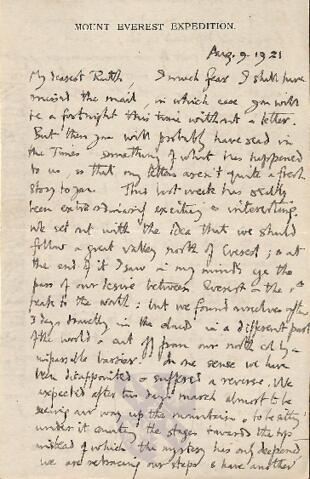Zona de identificação
Código de referência
Título
Data(s)
- 9 August 1921 (Produção)
Nível de descrição
Dimensão e suporte
1 item, paper
Zona do contexto
Nome do produtor
História do arquivo
Zona do conteúdo e estrutura
Âmbito e conteúdo
Letter to Ruth Mallory, written on ‘Mount Everest Expedition’ Letterhead
Brief Summary
Describes his and Bullock's reconnaisance. Initial misunderstanding about he two Chomolingas. Describes troubles with rations, taking photographs and the landscape and flowers.
Detailed Summary
There would be reports in The Times about the expedition which had been extraordinarily exciting and interesting in the last week. Their idea was to follow a great valley north of Everest where they saw the pass of their desire between Everest and the first peak to the North, but after three days travelling in the clouds they found they were cut off from the north col by an impassable barrier. They were disappointed. They were retracing their steps and this misadventure was part of the reconnaissance.
Describes their first day’s march, getting rations at a village, and being told by locals that the way to Chomolungma [Tibetan name for Everest] was to the left but they soon made disconcerting observations that they were not going the correct way. On the second days march they went up 4,000 ft seeing lovely flowers, two pretty lakes and grazing ground for yaks.
Then headed south west but from Kharta their direction should have been due west. Their local guide told them there were two Chomolungas, they guessed the other was Makalu. Explained they wanted to go to the one which was to the right. On the following morning's march there was a steep valley bed, a stream, a rickety bridge, lovely meadows, the end of a glacier, and a steep hillside running up to a tremendous cliff. They were following a valley from Makalu to Everest.
Reports on rain, Tibetan tents, and feeling baffled as they wanted to be to the north of the east or north east ridge. There was another valley running east and west ending in the col between Everest and the North Peak.
They saw the great east face of Everest and assessed that all the lower slopes were impossible from a climber’s point of view. Describes the east ridge and landscape. The following day they pushed on toward an advance camp to about 18,000 ft in poor weather.
Woke on 7 August to a cloudless starry sky. Describes the colours of the mountains. The whole range of peaks far exceeded any mountain scenery that he ever saw before.
He waited to take photos at sunrise and if they didn't come out well he would cry. Their objective was to get up a pass and a big glacier that blocked their view to the north col. Had a hurried breakfast, took more photographs and pushed toward the third peak from the east ridge of Everest.
They could see clearly that Everest joined other peaks and wanted to see more. Bullock thought the next section would prove impossible and it was stiff work. Whilst the party lay down and slept he took photographs and examined the north peak. As the desired view was still hidden he took two volunteers to the top with him. It was only a matter of 500 ft, but the snow was very deep and lying at a terribly steep angle and they had a struggle. They got to the summit of that peak and he could see a high snow cwm under the north east face of Everest. The next objective was to find the outlet.
The next day’s march would take them through an undiscovered country. For the first time he was not feeling perfectly well. The glands of his throat and most of the muscles were affected but that could be nothing to do with the exertions of climbing.
There had been trouble about the porters' rations. Wollaston and Morshead were at Kharta and Wheeler was not expected for another fortnight. Describes the flowers he had recently seen and thought they might be a new discovery. Was disappointed when Howard-Bury told him Wollaston had made an earlier discovery.
Was sorry he couldn't share his photographs with her. The bad ones were hardly worth sending and Howard-Bury had sent some photos home to the Royal Geographical Society. Suggests she find a way of seeing them there.
Avaliação, seleção e eliminação
Incorporações
Sistema de arranjo
Zona de condições de acesso e utilização
Condições de acesso
Condiçoes de reprodução
Idioma do material
Script do material
Notas ao idioma e script
Características físicas e requisitos técnicos
Instrumentos de descrição
Zona de documentação associada
Existência e localização de originais
Existência e localização de cópias
Unidades de descrição relacionadas
Zona das notas
Identificador(es) alternativo(s)
Former Reference
Pontos de acesso
Pontos de acesso - Assuntos
Pontos de acesso - Locais
Pontos de acesso - Nomes
- Bullock, Guy Henry (1887-1956), diplomat and mountaineer (Assunto)
- Howard-Bury, Charles Kenneth (1883–1963), mountaineer and army officer (Assunto)
- Wollaston, Alexander Frederick Richmond (1875-1930), naturalist and explorer (Assunto)
- Morshead, Henry Treise (1882–1931), surveyor, explorer and mountaineer (Assunto)
- Mallory [née Turner], Ruth (1892-1942), wife of mountaineer George Mallory (Assunto)
